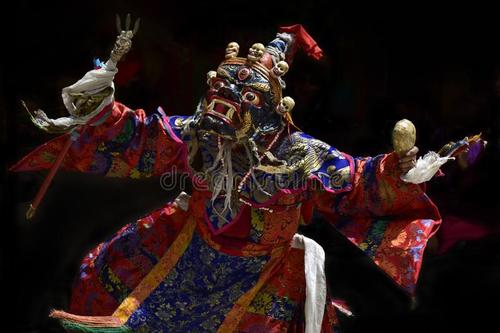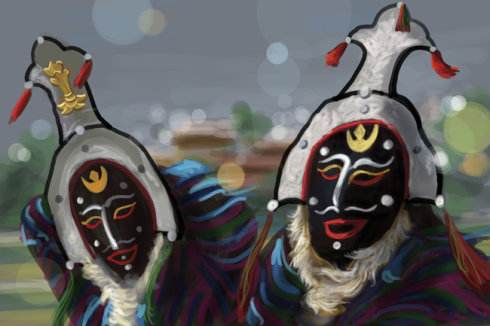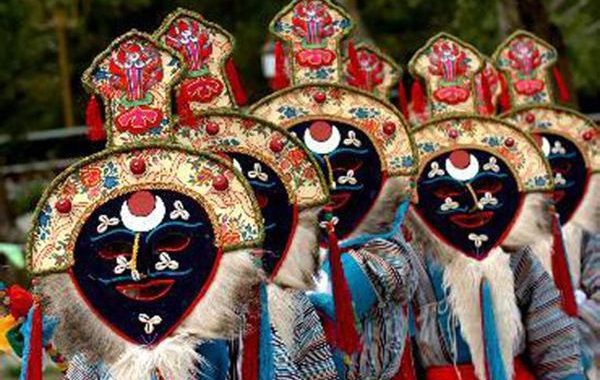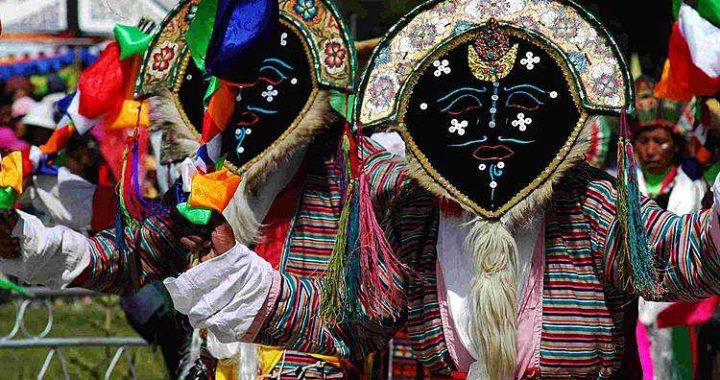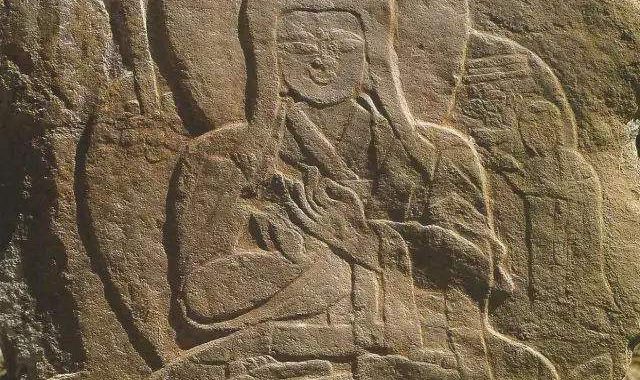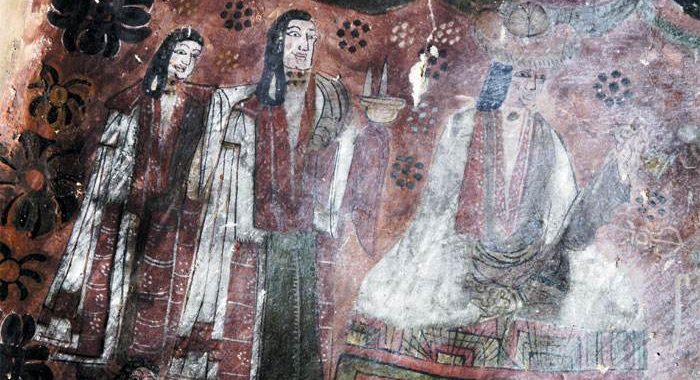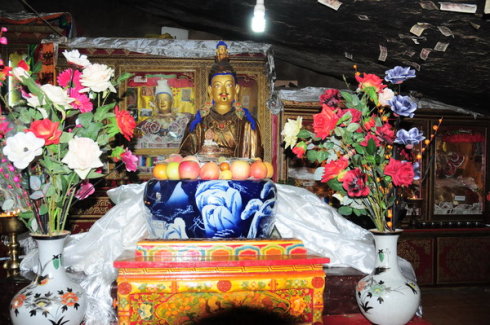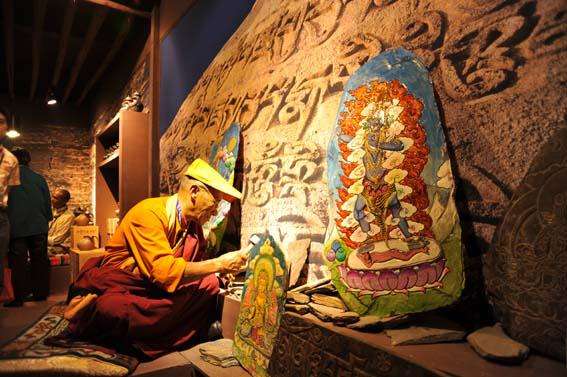Important works of singing and dancing
8 min readReba on the Grassland
The Tibetan song and dance, Reba on the Grassland, was composed by Tibetan dancer Omi Jiacan with the help of Han scenarists. The leading performers included Tsering Drolma, successor of Chagyab Reba of the Song and Dance Troupe of Tibet Autonomous Region and Tsering of Tibetan opera in Chomlung. By virtue of the graceful and unique dance, beautiful Biwang(ox horn stringed plucked instrument) tweedle, and the superb skills of the Tsering player of Tibetan opera, Reba on the Grassland had an outstanding artistic effect. The ensemble took part in the 6th World Festival of Youth and Students held in Moscow in 1957 and won the sliver award.
The Night of Harvest
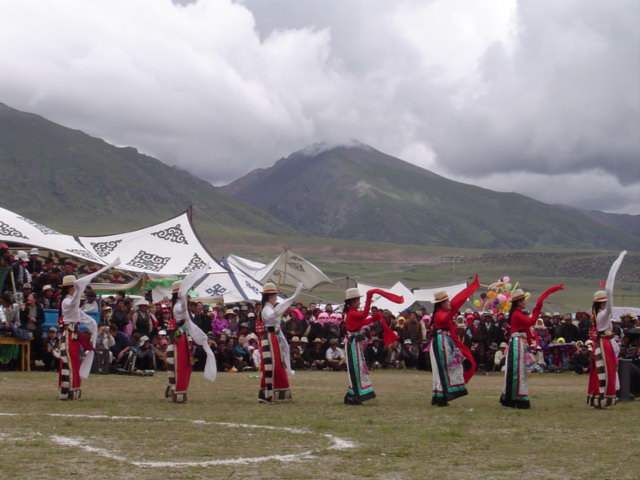
The Night of Harvest,a collective song and dance program, was created and performed by the Song and Dance Troupe of Tibet Autonomous Region from 1959 to 1964. Composed by Zhou Mingde, it was created for the troupe to celebrate 10th anniversary of the founding of the People’s Republic of China, and the first work created after the establishment of the troupe. The music was developed from the basic tone of “Stod-gzhas”in Tsang and”Sgor-gzhas”in U-Tsang, and retained the basic characteristics of “Stod-gzhas”while using new composition technique. The work reflected the optimistic and uplifting spirit of Tibetan people and the spirit of the prevailing environment.
Visiting the New City
The dual song and dance program, Visiting the New City, was created in 1960 with lyrics written by Deng Xiankai and music composed by Li Caisheng. Visiting the New City was first staged by Bai Xingwu(the role of daughter) and Zhang Xinmin(the role of father).
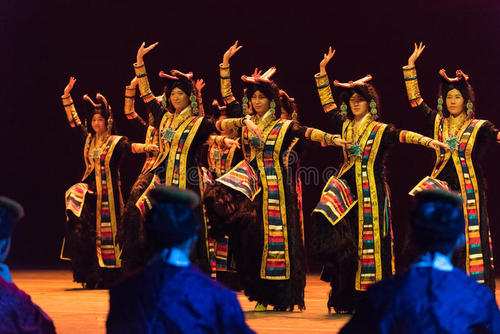
It was performed by Lhasa Ethnic Art Troupe in 1963 in Tibetan and this version was recorded in 1973, performed by Thubten and Phuntsok Drolma. After the democratic reform in 1959, Lhasa experienced significant changes in the appearance and the song was close to the background with a strong ethnic flavor. The program created roles of the father and daughter who were liberated serfs, reflecting the excitement of Tibetan people. The work had a strong flavor reflecting the current environment and rapidly became popular after its debut. It was among the programs that had strong a stage presence in the 1960s. Theperformance characterizes rondo and adopts the Gong-melody. The prelude is set off with a bamboo flute and the speed quickens to free melody, creating a clear and happy artistic conception before the singing starts.
Laundry Song
From 1962 to 1964, Laundry Song was created and performed by the art troupe of Tibetan Military Area Command, with lyrics written by Luo Nianyi and Li Junchen, music composed by Luo Nianyi, and dance composed by Li Junchen. The work combines singing, dancing and music.
The lyric flute is the prelude before the main part which consists of a female singing accompanied by dancing from the head of the cooking squad and followed by the laundry dance, and finally the epilogue. The song radiates the tone of the folk music of Tibet such as Jiangzuolin Canzonet in Chamdo and Batang, concise and lively, joyful and passionate.
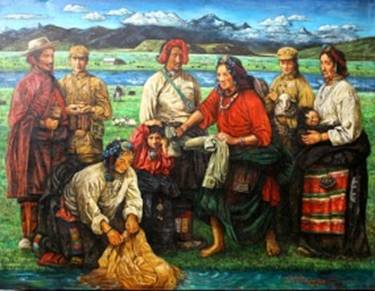
The authors made bold innovation to induce a mixed tune with eight sound levels and two pentatonic scales from the folk songs, featuring a strong flavor of modern music and Tibetan charm. The program won thefirst creative award at the 3rd Art Performance of the PLA in 1964, courtesy of the unique form, beautiful melody, distinct theme and characteristics of the times. Later it became popular across China.
The scenario develops from two figures; the PLA squad head and little Dolker. The head of the cooking squad is willing to assist his comrades in washing clothes. Girls with little Dolker, who are the main feature, voluntarily help the squad head in these chores. The scenario expands to focus on”washing clothes,”singing highly of the relationship between the officers and civilians. In terms of movement, the performance is based on “Kang Gzhas”while boldly changing the original “Sgor-gzhas.”Washing clothes using hands and by trampling, the scene is lively with a robust atmosphere and the color of life.
Liberated Serf
The epic musical dance, Liberated Serf, was created in 1965 to celebrate the official founding of the Tibet Autonomous Region. The theme song, We Leap into the Socialist Society, reflects the aspiration of millions of liberated serfs in Tibet and mirrors their special moments.
Spring of Sherpa
The Spring of Sherpa was created and staged by the Song and Dance Troupe of Tibet Autonomous Region with Huang Wanli as the choreographer. It was created by using techniques and materials of Sherpa folk songs and dances while absorbing the elements of Indian andSpanish dance to generate unique artistic effects. It emerged the winner at a professional dance competition of Tibet and took the top award in dance creativity at the ethnic art performance in 1980.

Lhamo Yangjenma
Lhamo Yangjenma embodies the spiritual connotation of the traditional music goddess and was staged by the Song and Dance Troupe of Tibet Autonomous Region in 1984 with Huang Wanli as the choreographer. The director combined various Buddha gestures such as playing pipa,a four-stringed plucked instrument, Biwang, flute, conch and drum and the postures of the music goddess with the curves of nature, and extracted six female religious dance elements as the main movements of Lhamo Yangjenma. Meanwhile, the movements of Tibetan opera,”Nang-ma,””Stod-gzhas,””Sgor-gzhas”and other folk dances were incorporated into the performance in line with specific time and space to repeatedly render the flowing “group sculptures”embodying “tranquility and dynamics”by the comparison of size, height and status. It embodies the classical beauty of nature and of the goddesses.
Large ethnic musical drama, Passion in Reba
The huge ethnic musical drama, Passion in Reba, was first created and staged in 1983 by the Song and Dance Troupe of Tibet Autonomous Region, with playwright Li Chengxiang, directed by Pasang Tsering, Renjincaizhen and Wang Wanli among others, and music composed by the first generation composers Palden Namgyal and Kelsang Dajie of Tibet. It was another masterpiece following the hugely successful musical drama, Liberated Serfs, which was the crystallization of talents of theartistic workers of Tibet. It consists of the prelude, Long MountainousPath, the first act; Disturbance in the Market, the second act; Lingering Affection in the Dense Woods, the third act; Phantom in the Buddhist Prayer Room, the fourth act; Elegy at the Manor.
The music absorbed the tones of “Xianzi,””Guozhuang,””Stod-gzhas,
“”Nang-ma,””Bell and Drum Dance”as the raw material and the composition techniques of western symphony. The band adopted the double wind band established with several ethnic music instruments such as Erhu to imitate the Ox Horn instrument of Reba artists. The bamboo flute plays the role of changes and the trombone and French horn to imitate the sound effect of the religious horn and dextral shell. This performance inherited the excellent ethnic music traditions of Tibet and boldly absorbed foreign music composition techniques.
Large-themed singing and dancing, Ode to the Wild Geese
The big-themed singing and dancing Ode of the Wild Geese was created and staged by the Song and Dance Troupe of Tibet AutonomousRegion in 1995, with Tenzin Gonpo as the chief choreographer, and Jr.
Tsering Dhondup, Bai Ji, Ya Yi, Wei Dong as directors. It was presented to celebrate the 30th anniversary of the founding of Tibet Autonomous Region. The work reflects the achievements of Tibet during the 30 years by means of the wild geese that delivered news of reform and opening up and modernization from the south. It is full of “conflicts”between modern and traditional ways of thinking. With rich characteristics of a phonic suite, the performance is divided into the prelude and three movements based on the scenario. The prelude combines religious music, royal court music, and the voice of Tibetan opera, reflecting the rich cultural background of the snow-covered plateau.
From the aspect of styles, the program features the rhythm and style of traditional Tibetan singing and dancing Gzhas-chen, Rgya-kzhas, Reba Guozhuang, Xianzi, Sgor-gzhas and herdsmen dance and movement techniques of ballet and modern dance introduced from abroad. With the grand scene, rigid structure, novel artistic vocabulary and elegant style, the act vividly presents the great aspirations of Tibetan people forging ahead in unity and writing a new chapter of modernization.
In 1997, it won the Wenhua New Play Award by the Ministry of Culture and the highest artistic creation award -the Everest Literature and Art Fund Award of Tibet Autonomous Region.
Drum Dance Competition of Eastern Tibet
The collective song and dance Drum Dance Competition of Eastern Tibet was created and staged by Chamdo Ethnic Song and Dance Troupe.
It absorbs the essence of the religious drum dance of Chamdo, Markham, Zogang, Riwoche and other areas and features the charms of Reba. It uses four types of drums to play different tunes and drumbeats and different rhythms and styles. The movements of male dancers are bold and vigorous accompanying a slow and solemn drumbeat while the movements of female dancers are beautiful and elegant with a clear and deft drumbeat.
Ode to Reunion
The theme concert Ode to Reunion was created in July 1997, choreographed by Tenzin Gonpo, music composed by Kelsang Dargye, Geleg, Biansuo, Suomani and Lozang Samten among others and lyrics by Dbang-vdus. It was a themed performance by the local government of the Tibet Autonomous Region created for celebrating the return of Hong Kong. The work combines different artistic forms such as solo, chorus of Tibetan Opera, and dance to reflect the excitement of peoples of all ethnic groups in Tibet for the return of Hong Kong.
Sword of Lhoba People
The dual song and dance program of Lhoba people, Sword of Lhoba People, was created and staged by the Song and Dance Troupe of Tibet Autonomous Region, with Yayi as the choreographer. The choreographer designed a set of very typical dance images: the male dancers holding swords with their right hand, raising their right foot with the upper body diving forward while the female dancers hold the left foot of the male dancers on the ground. These movements are linked with the life of “slash and burn”farming method of Lhoba people. The work attempts to tell a story of an ancient ethnic group using unique and simple movements andshowcase the spiritual outlook of the ethnic group towards the future.
In October 2000, it won the first prize for dual dance choreography and performance and scooped the third prize in composition at the 10th Peacock Award for Ethnic Group Dance Competition.
Epic singing and dancing Qomolangma
The epic theme singing and dancing Qomolangma was created in 1999, with music composed by Xie Zhenqiang(Xiaochong) and Meilang Dorj, and chief choreographer Pasang Tsering, jointly with the Song and Dance Troupe of Tibet Autonomous Region, and choreographers, composers, scenarists and music producers from Beijing, Sichuan, Guangzhou and Hong Kong. It was created to celebrate the 40th anniversary of Tibet’s democratic reform and the 50th anniversary of the founding of the People’s Republic of China. This work reflected the historical changes of the young Qinghai-Tibet Plateau, its emergence from the seabed in ancient times, and the great effort of Tibetan people to create their splendid civilization in an extremely harsh environment. It was a masterpiece about the Qinghai-Tibet Plateau and won the gold award at the 6th Chinese Arts Festival in 1999.
Chapter Two
The Religious Dance Accompanied
by Music
The Tibetan religious dance has a long history and varies greatly. It was mainly divided into monastery religious dance Vcham(also known as “Tiaoshen,”sorcerer’s dance in a trance) and worldly religious dance “Mina Vcham.”
